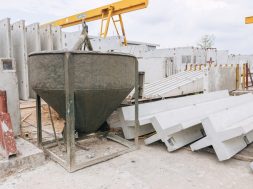BIM beyond Designing and Detailing [Feb 2012]
“BIM is often mistakenly considered as design and detailing software. Nowadays, it is even preferred as an effective tool in managing construction”, says Nirmalya Chatterjee, COO, Tekla India
Discuss the technological evolution in the areas of structural designingThe use of IT in construction has made available a trustworthy, synchronized, and consistent digital representation of the building for design-decision making, high-quality construction, document production, construction planning and performance predictions.
Technological advances and new software have altered the face of engineering design sector. In days gone by, the Indian building design and construction industry has shown a escalating interest in two topics: Integrated Project Delivery (IPD) and Building Information Modelling (BIM). At the same time, construction companies themselves have become increasingly open-minded about technology due to an immeasurable pressure on developers, contractors and architects to ensure projects are delivered on time and within budget.
Earlier the construction processes were quite fragmented, with involvement of different project parties overseeing different stages such as the sales and tendering, design, detailing, production, delivery and erection/installation. IPD provides the opportunities to alleviate the fractured and contentious nature of information and communication between project stakeholders seamlessly, while BIM offers the technology to deliver coordinated design and construction information in a new, intelligent, and 3D visual environment.
The rush of attention in and around IPD and BIM has, in many cases, diluted their respective value propositions. Especially in the case of Building Information Modelling, designers and contractors alike have seen the marketplace flooded with competitors that tout the use of internal rendering tools and spatial analysis systems (i.e. clash detection) as value-added services to their clients. While these admittedly are exciting advancement in technologies, they in no way try to innovate past the standard scope of services included in design documentation and construction responsibilities.
Could you highlight on the different technologies available in the market today?The industry is still learning about BIM and how to utilize software in the best possible way. Steel industry leads the way for the rest of the construction disciplines. The leading and biggest construction and engineering companies are aware of and use the most advanced solutions, but getting owners and small and medium-sized subcontracting companies involved is still a challenge and depends much on the awareness and requirements of project owners as well as short-term financial benefits.
Nowadays BIM is even preferred as a construction management tool. The use of BIM goes beyond the design phase of the project and takes an important role during the construction phase of a project as well as the post construction phases and facility management. The entire purpose of BIM was to make the construction process more efficient and eliminate as many uncertainties as possible before starting the construction process. Participants in the building process are constantly challenged to deliver successful projects despite tight budgets, limited manpower, accelerated schedules, and limited or conflicting information. Innovations in BIM boast of capabilities to ease the pain of project delivery. The concept of Building Information Modeling is to build a building virtually prior to building it physically, in order to work out problems, and simulate and analyze potential impacts. Furthermore, along the project anticipation and ease of project delivery, the overall safety of the project will improve due to the elimination of uncertainty. The work site is safer because more items will be pre-assembled off site and trucked to the site keeping the on-site trades to a minimum. Waste will be minimized on-site and products will be delivered when needed and not stock piled on site. This will make a great impact in the way a construction project is managed and will bring along a safer jobsite and more accurate construction with a more sophisticated design process, which will allow sub contractors from every trade to input critical information into the software before the beginning of the actual construction. Tekla Structures Customers are gaining benefits of a complete BIM solution that address the whole projects need.
How do you see the acceptance of modern technology as far as Indian construction industry is concerned?More and better knowledge about BIM is available in the construction industry, but it’s still often mistakenly considered as design and detailing software. Real BIM goes much beyond and is actually more a methodology that is enabled by and incorporates new design and collaboration technology.
As more and more project participants in India have started adopting BIM technology, further awareness is required regarding software interoperability and compatibility and how to share and distribute the building information models of different disciplines using model servers.
What are the prime barriers in adopting the latest technologies?The emergence and adoption of BIM represents an industry wide paradigm shift. The reluctance to implement the new technology might be due to several factors with the biggest ones being the switching costs, which are related to learning a new technology, and the cost of the BIM software in relation to how much value it adds and what services it provides. The paradigm shift that relates to constructing and designing buildings in a new way requires a new approach throughout the value chain and it is certainly not done overnight.
It seems that customers are sceptical whether a single BIM can work in practice due to practical variability in different phases and projects of construction modelling. For example, customers argue that project requirements are different for each project and the requirements determine the best application. Thus, project teams rely on purpose-built models since they are optimised for specific project needs.
For an owner, contractor and designer, learning the new technology does not represent the biggest problem but rather the investments in changing the culture, processes are high, and the actions are difficult to implement. Despite of the recent developments in BIM, the construction industry players are aware of two risks that might be involved in adopting a single BIM technology. There is a risk that project team is not collaborative which is one of the factors which guarantees the efficiency of the BIM technology. The second risk relates to technology: the project participants need to be reliant that the tool is accurate and that it has been updated. Despite the resistance, industry players should recognise that BIM has an important role in creating and coordinating objects as a source of intelligent information about a construction. If industry players, even small ones are trained to use BIM technology and they become BIM-enabled sub constructors, BIM will gain more traction and has potential to becoming an industry standard sooner than thought.
Could you discuss about Tekla’s initiatives in diminishing such barriers? In order to diminish such barriers Tekla has already launched two new technologies to address the construction industry:
Tekla BIMsightTekla BIMsight is a professional tool for construction project collaboration. All disciplines of the construction workflow can combine their models, check for clashes, mark up & share the information using the same easy-to-use 3D environment. Tekla BIMsight can play a big role by consolidating project information from all stages, allowing project participants to identify and solve issues already in the design phase before the actual construction. By minimising error, construction firms save on unnecessary material, labour costs and achieve significant improvements in productivity and quality. Tekla BIMsight is free to use & the same can be downloaded from the website www.teklabimsight.com
Tekla Construction Management moduleTekla Structures, Construction Management Module manages and track project status. Users can communicate and manage information from supply to installation. Since building information consists of both business and process information, this configuration offers more than just reviewing project data created by others. Customised views allow the user to create and change information attached to building objects. Project history can be accessed and presented graphically or in text format. Clashes can be highlighted so that problem areas are easier to identify.
To educate construction professionals on BIM technology, Tekla India has already opened up Tekla Center of Excellence – a unique training center concept in few cities like Mumbai, Pune, Bangalore, Chennai and expanding possibilities of opening training center throughout India. Tekla India is targeting to produce 500 qualified professionals trained on BIM technology by the Year 2012.
Significance and advantages of 3D BIM Technology:
BIM Technology makes construction more sustainable
BIM minimise wastage of material, power and transportation, costly reworking and documentation
Accurate material lists and scheduling to financial and material management systems directly from the model
Leaner process with less waste and better possibilities for controlled recycling of extra materials in the factory
Interoperability with the best solutions
Wider usage of structural model in the construction process
Increased productivity, elimination of waste, and more sustainable construction and buildings
Direct communication with machinery to integrate design to production without error-prone key-in
Preconstruction moved off site, fewer errors on site.
For further info contact:Tekla India Marketing Team, Email – info.india@tekla.comTel: +91-22-61387777
Cookie Consent
We use cookies to personalize your experience. By continuing to visit this website you agree to our Terms & Conditions, Privacy Policy and Cookie Policy.






